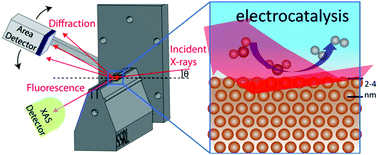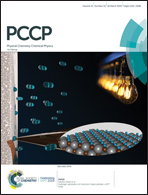Electrochemical flow cell enabling operando probing of electrocatalyst surfaces by X-ray spectroscopy and diffraction†
Abstract
The rational improvement of current and developing electrochemical technologies requires atomistic understanding of electrode–electrolyte interfaces. However, examining these interfaces under operando conditions, where performance is typically evaluated and benchmarked, remains challenging, as it necessitates incorporating an operando probe during full electrochemical operation. In this study, we describe a custom electrochemical flow cell that enables near-surface-sensitive operando investigation of planar thin-film catalysts at significant hydrogen evolution reaction (HER) rates (in excess of −100 mA cm−2) using grazing incidence X-ray methods. Grazing-incidence X-ray spectroscopy and diffraction were implemented on the same sample under identical HER conditions, demonstrating how the combined measurements track changing redox chemistry and structure of Cu thin-film catalyst surfaces as a function of electrochemical conditions. The coupling of these methods with improved mass transport and hydrodynamic control establishes a new paradigm for operando measurement design, enabling unique insights into the key fundamental processes occurring at the catalyst–electrolyte interface.

- This article is part of the themed collection: 2019 PCCP HOT Articles


 Please wait while we load your content...
Please wait while we load your content...